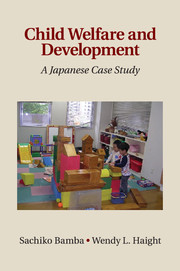Book contents
- Frontmatter
- Contents
- Tables and Figures
- Acknowledgments
- 1 Child-rearing at a Residential Child Care Institution
- 2 Japanese Contexts and Concepts
- 3 The Research Program
- 4 A Developmental Goal for Maltreated Children
- 5 Challenges to Maltreated Children’s Ibasho Creation
- 6 Socialization Practices Underlying Ibasho Creation
- 7 Children’s Lives and Experiences of Ibasho and Mimamori
- 8 Mr. Watanabe’s Responses to the Intervention
- 9 Reflections on Some Challenges of Field Research
- 10 The Emerging Child Welfare Context of Jidou Yougo Shisetsu
- 11 Conclusion: Some Lessons for Culturally Sensitive Child Welfare
- References
- Index
6 - Socialization Practices Underlying Ibasho Creation
Mimamori
Published online by Cambridge University Press: 07 October 2011
- Frontmatter
- Contents
- Tables and Figures
- Acknowledgments
- 1 Child-rearing at a Residential Child Care Institution
- 2 Japanese Contexts and Concepts
- 3 The Research Program
- 4 A Developmental Goal for Maltreated Children
- 5 Challenges to Maltreated Children’s Ibasho Creation
- 6 Socialization Practices Underlying Ibasho Creation
- 7 Children’s Lives and Experiences of Ibasho and Mimamori
- 8 Mr. Watanabe’s Responses to the Intervention
- 9 Reflections on Some Challenges of Field Research
- 10 The Emerging Child Welfare Context of Jidou Yougo Shisetsu
- 11 Conclusion: Some Lessons for Culturally Sensitive Child Welfare
- References
- Index
Summary
The children are enjoying some free time at the gym, on the playground, and within their houses before dinner. Several young boys are playing catch on the playground. Other children are playing with a ball on the stairs leading from the playground to the residential building, or jumping rope. Care workers occasionally pass by the side of the playground or roofed passages that connect buildings, and watch the children playing. Although male care workers sometimes join boys’ ball games, no adults are present today. As I observe several elementary-school-aged boys playing catch, one child is hit, hard in the face with a ball. One of the other boys calls out, “Are you all right?” but continues playing without approaching him. Another player teases the injured child, “You’re stupid!” A fourth child, however, approaches the injured boy and leads him to the side of the playground. There, the two boys confer with a female care worker who is passing by. She suggests that they put ice on the injured child’s face, but does not go with them to get it. Ten minutes later, the injured boy returns to the playground holding a small plastic bag of ice to his face.
Sachiko’s field note
- Type
- Chapter
- Information
- Child Welfare and DevelopmentA Japanese Case Study, pp. 99 - 116Publisher: Cambridge University PressPrint publication year: 2011

